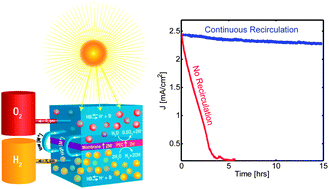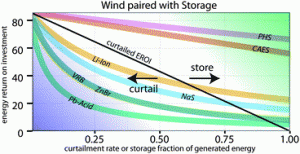In an exciting breakthrough in photoelectrochemical (PEC) solar generator development, a new report describes a methodology for robust H2 production in a near neutral environment.
The development of practical, sustainable solar fuel generators comes with many challenges. Not only do the materials and components used need to be cost-effective and abundant, but the devices also need to be able to consistently produce purified fuels over long periods of time under environmentally benign conditions. A challenge to meeting all of these requirements has been in the creation of devices that are stable using either strong acid or basic electrolytes. A recent EES paper by Modestino et al. describes the development of a controlled recirculating stream across reactions sites to yield continuous solar-hydrogen generation in near neutral pH electrolytes.
In this report, researchers from the Joint Center for Artificial Photosynthesis and collaborating institutions describe alternate ion transport pathways that allow for operation under a near neutral pH. By creating a recirculation scheme to balance the concentration across the membrane in a membrane-separated photoelectrochemical (PEC) system, the authors achieved robust production of separated product streams (pure hydrogen and oxygen) via their ion-transport membrane components.
Designing a PEC device that operates using neutral pH electrolytes enables the use of catalytic and light absorbing components that would degrade in acidic or basic environments. The methodology described in this paper can provide researchers with a platform to experiment with different materials and hopefully optimize solar-to-hydrogen efficiency. It will be interesting to see the implementation of this methodology in future research, and if this approach ultimately provides a good solution to one major obstacle in the creation of scalable, sustainable, and robust solar fuel generators.
Read more in the full EES article here:
Robust production of purified H2 in a stable, self-regulating, and continuously operating solar fuel generator
Miguel A. Modestino, Karl A. Walczak, Alan Berger, Christopher M. Evans, Sophia Haussener, Carl Koval, John S. Newman, Joel W. Ager and Rachel A. Segalman
Energy Environ. Sci., 2014,7, 297-301
DOI: 10.1039/C3EE43214A













